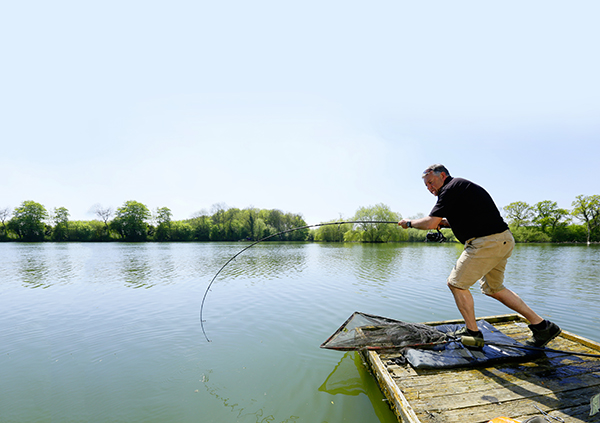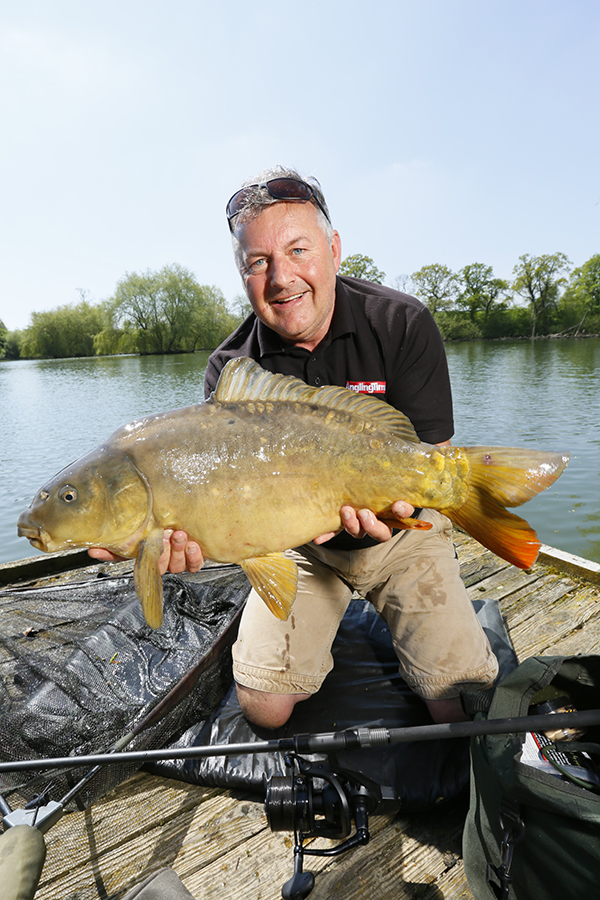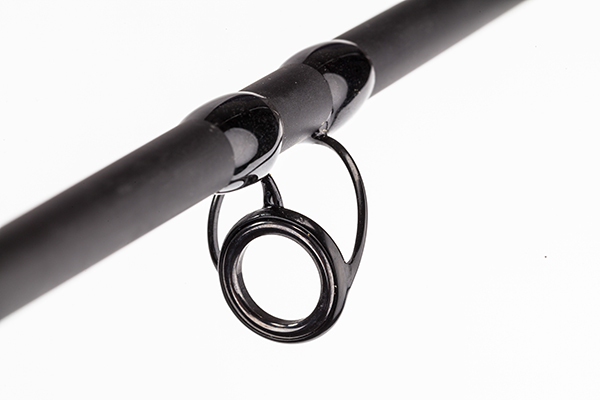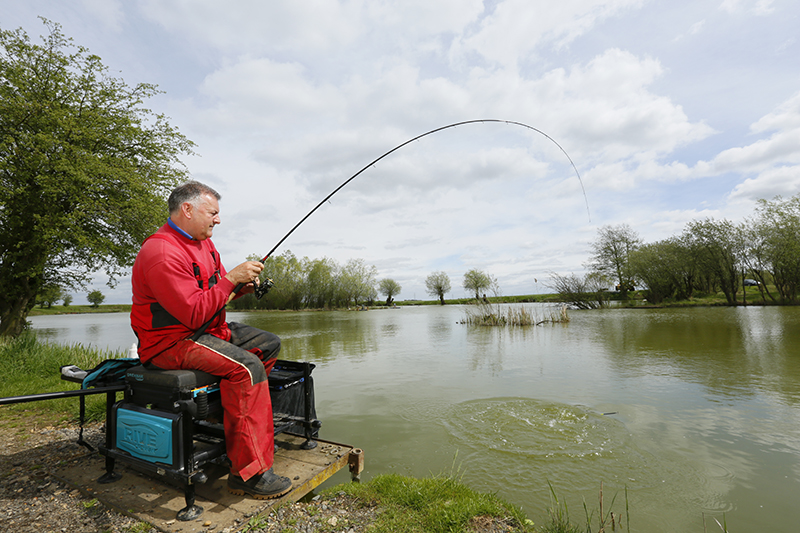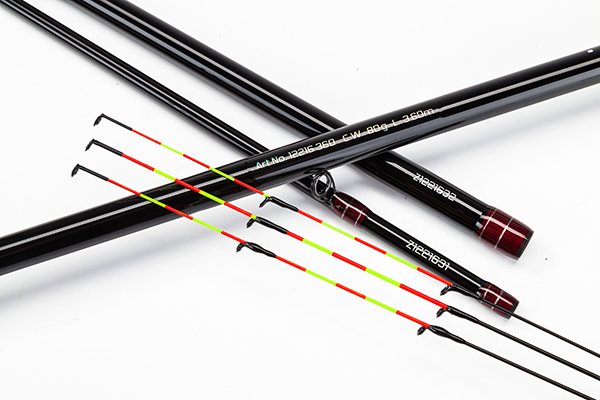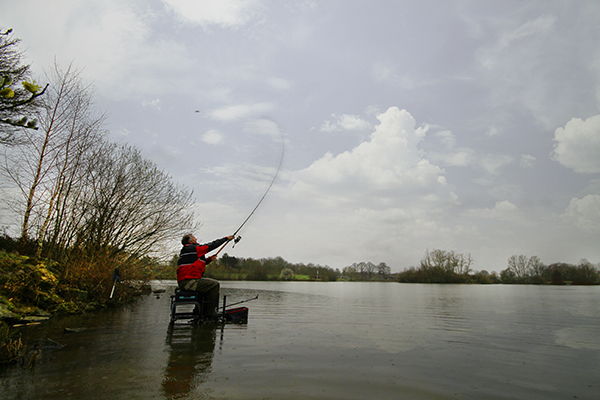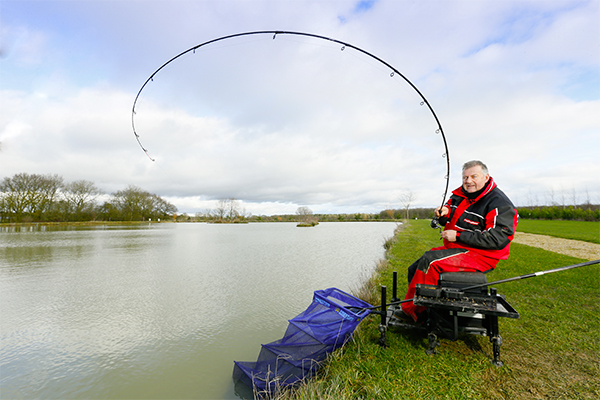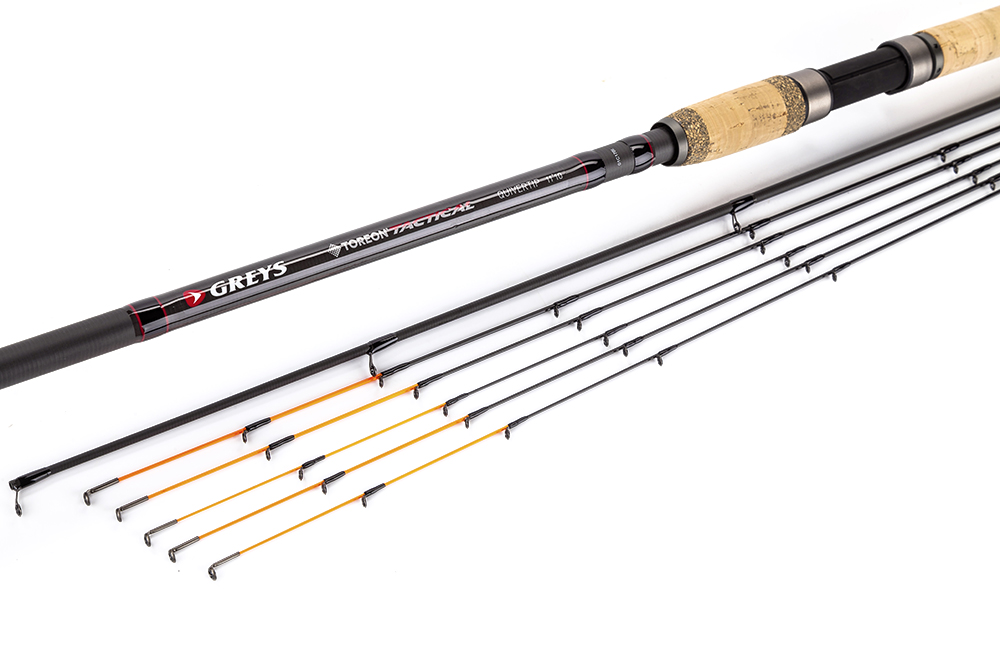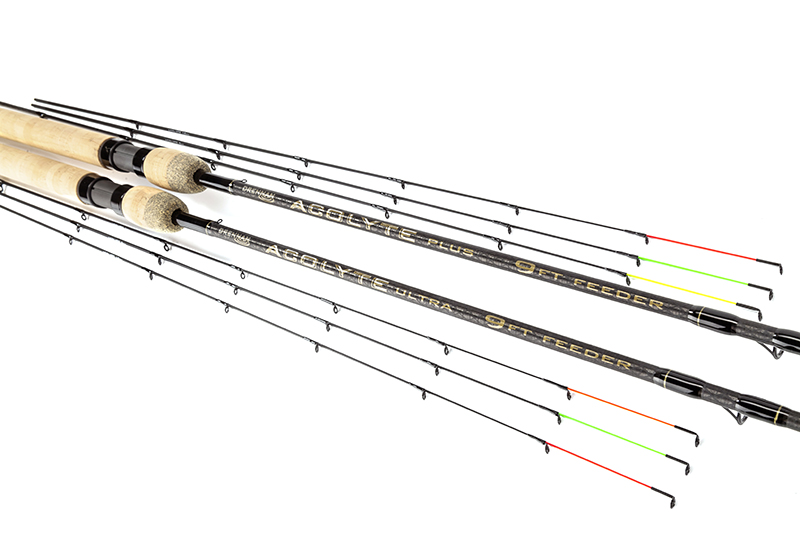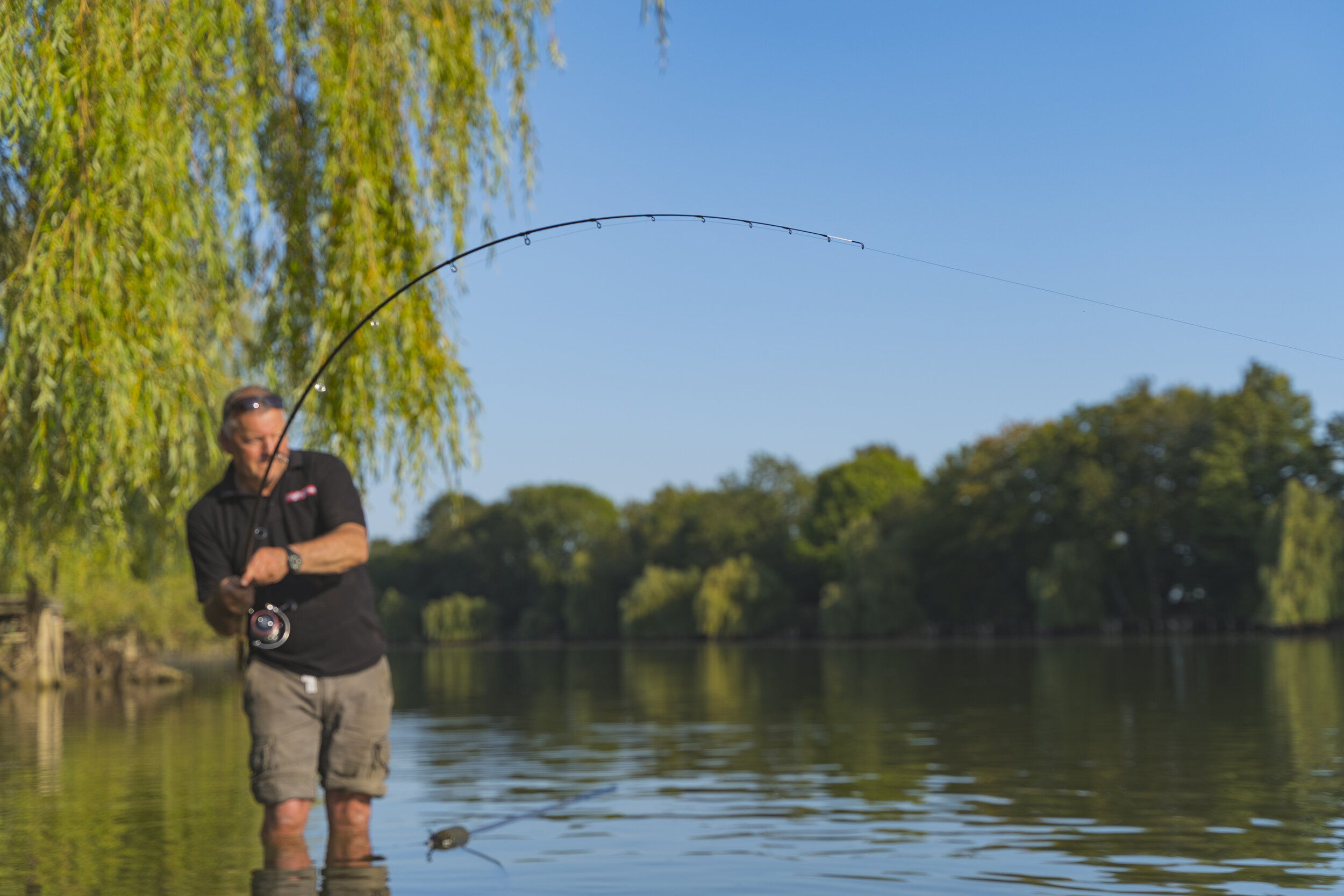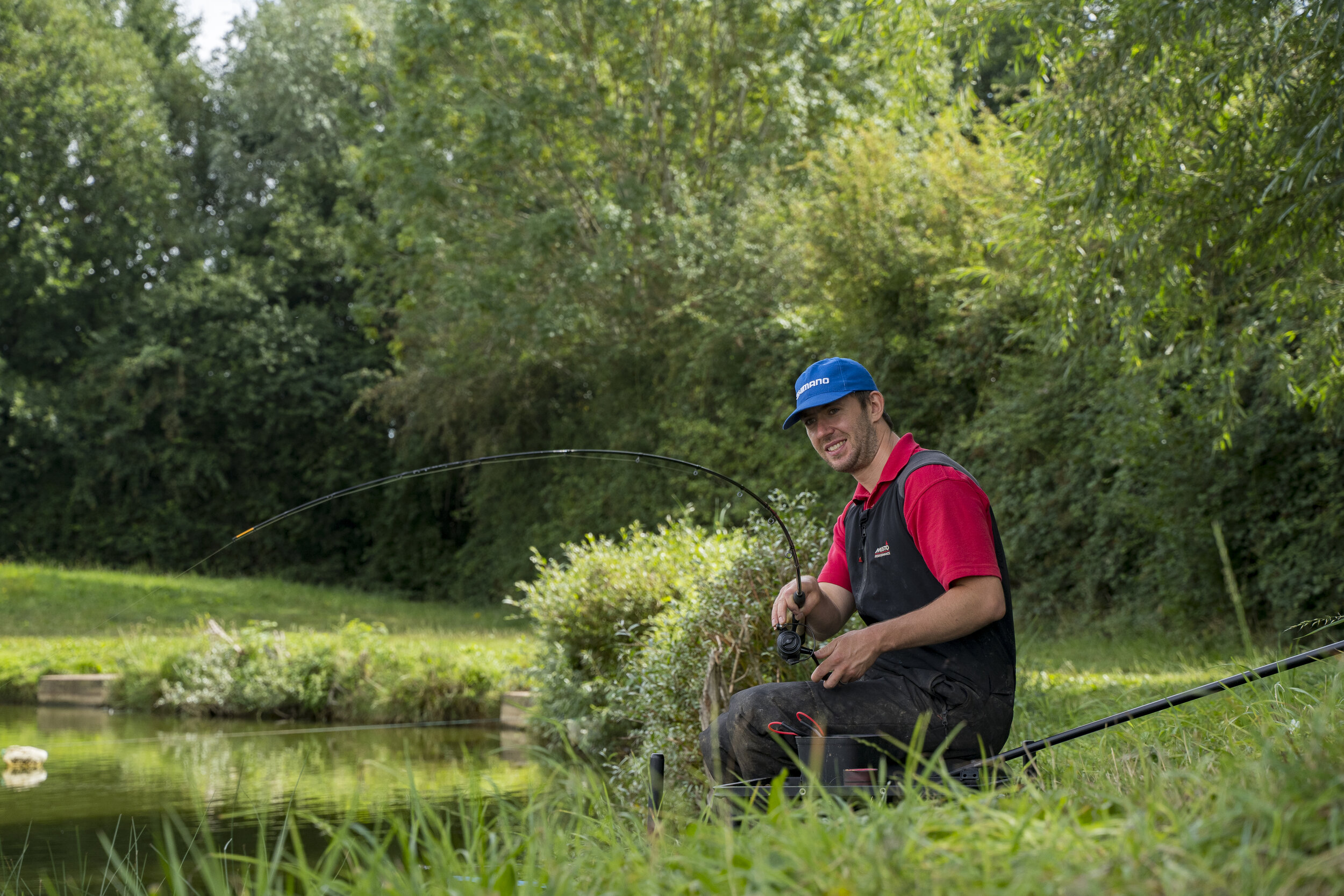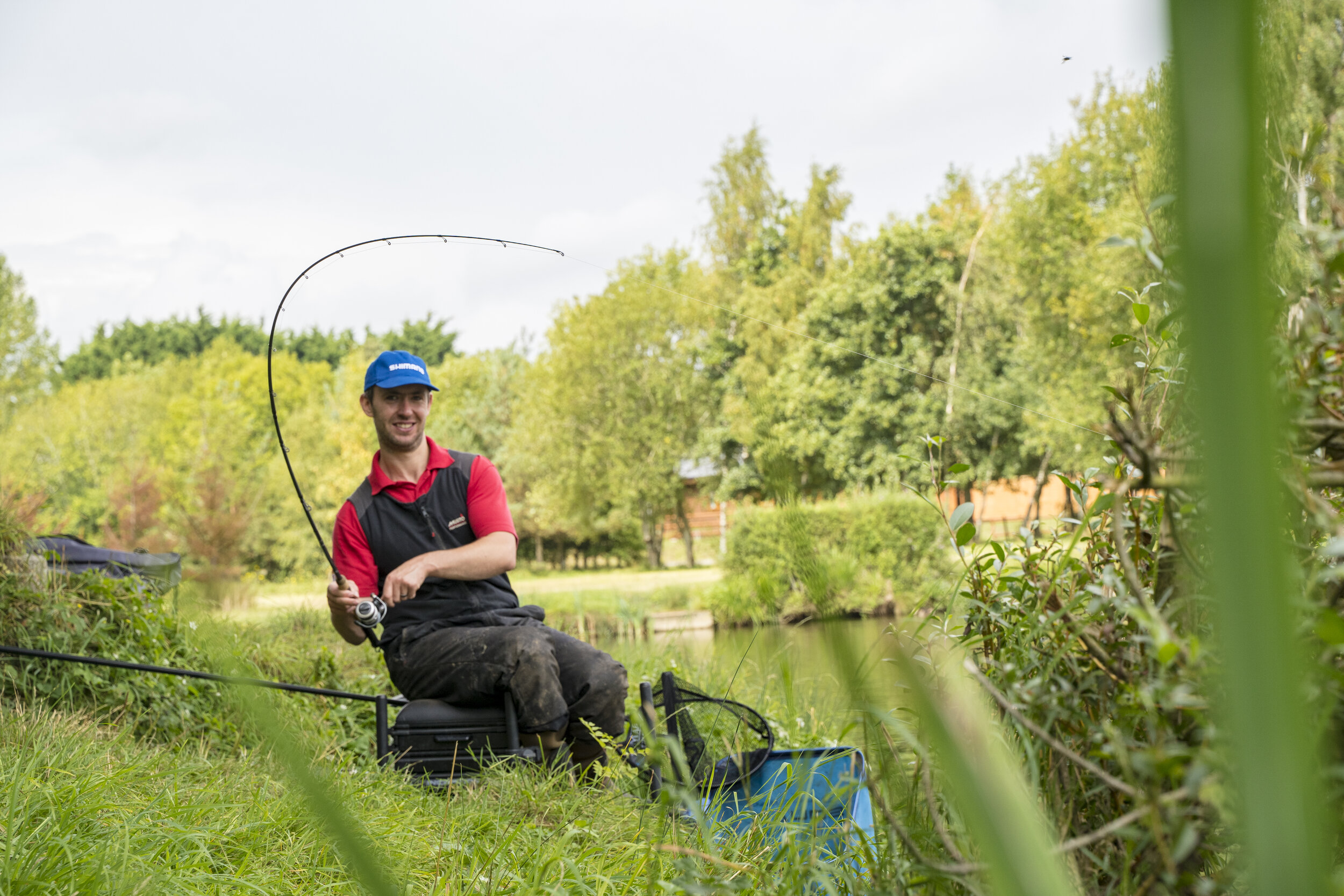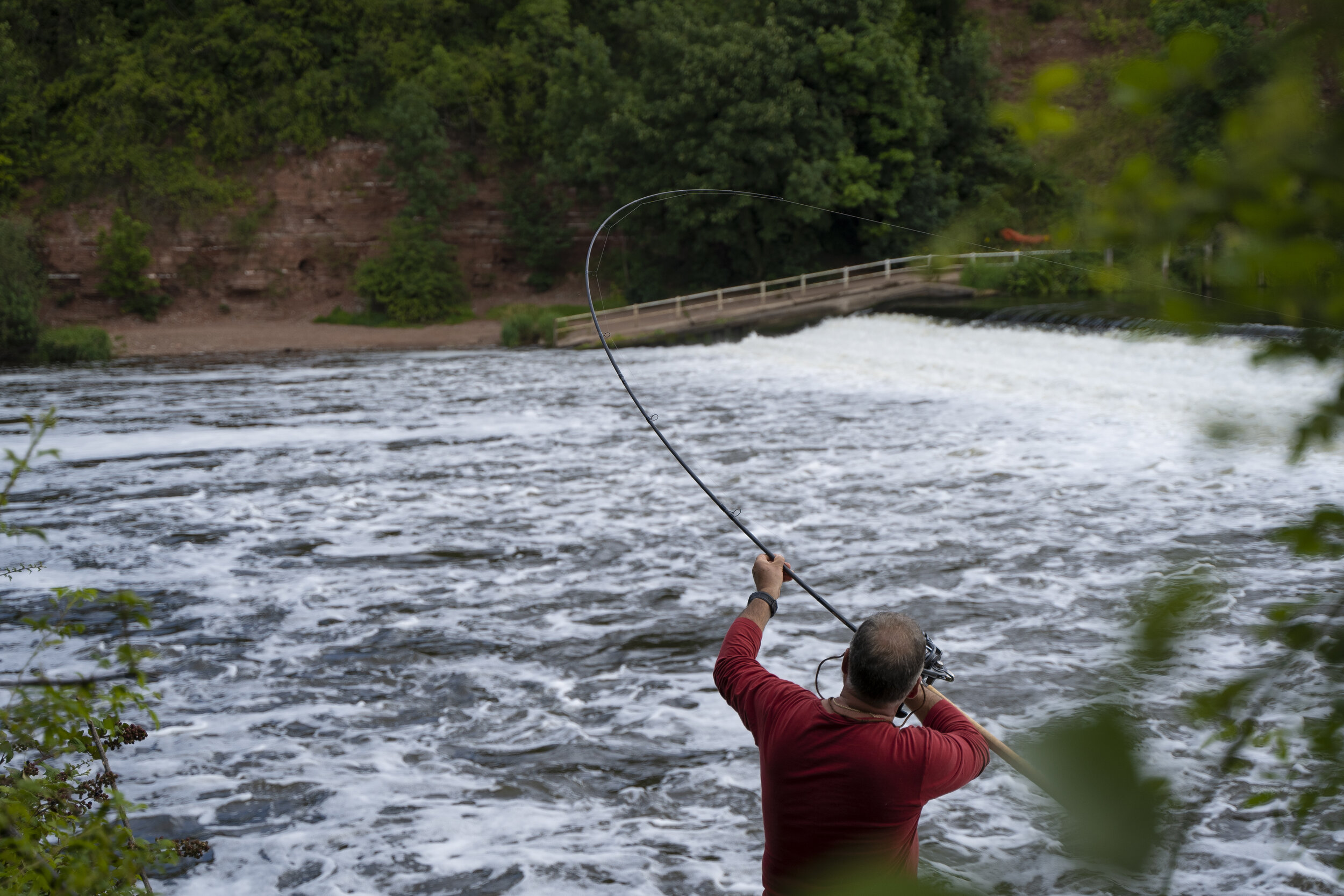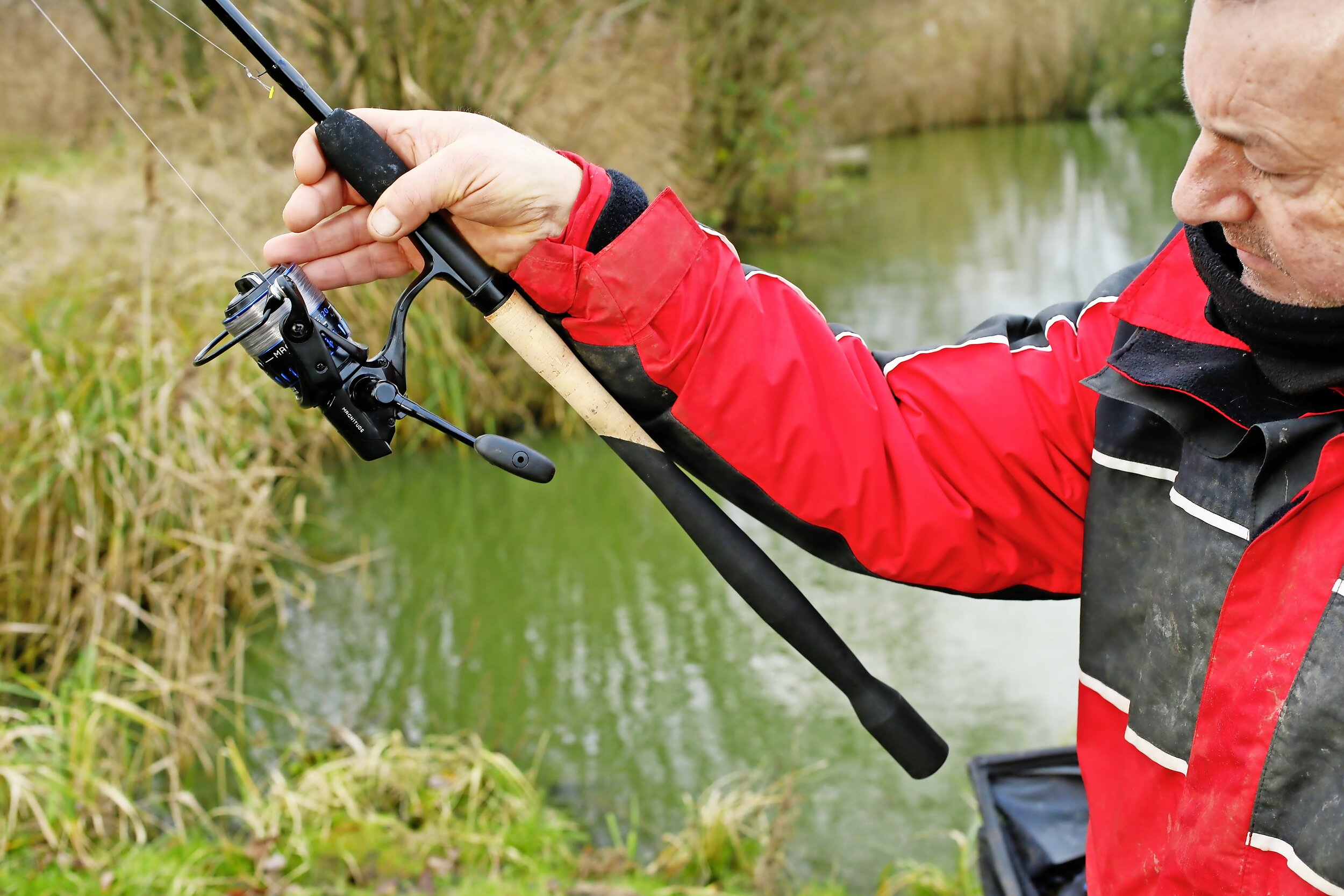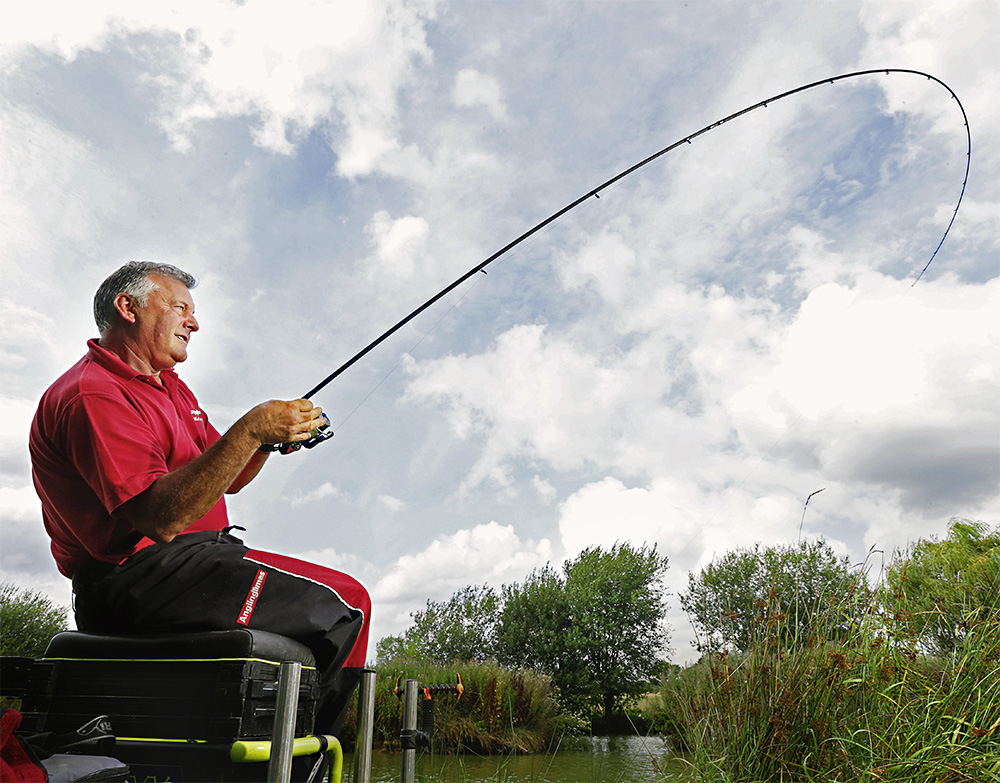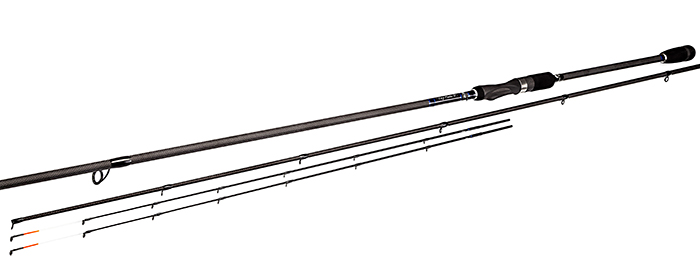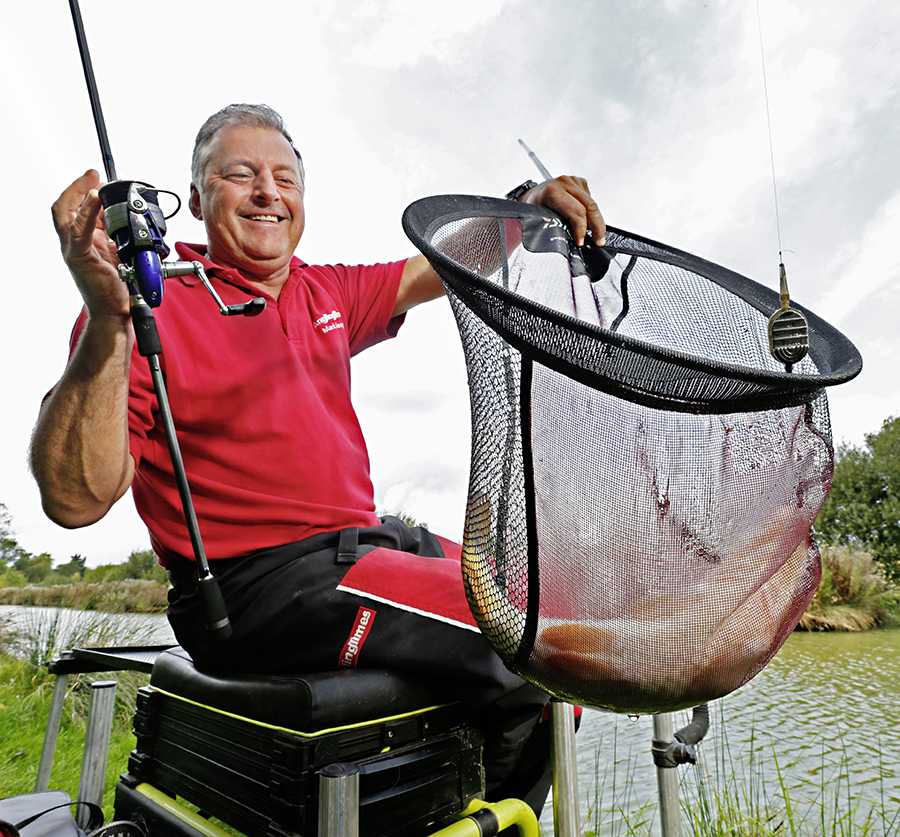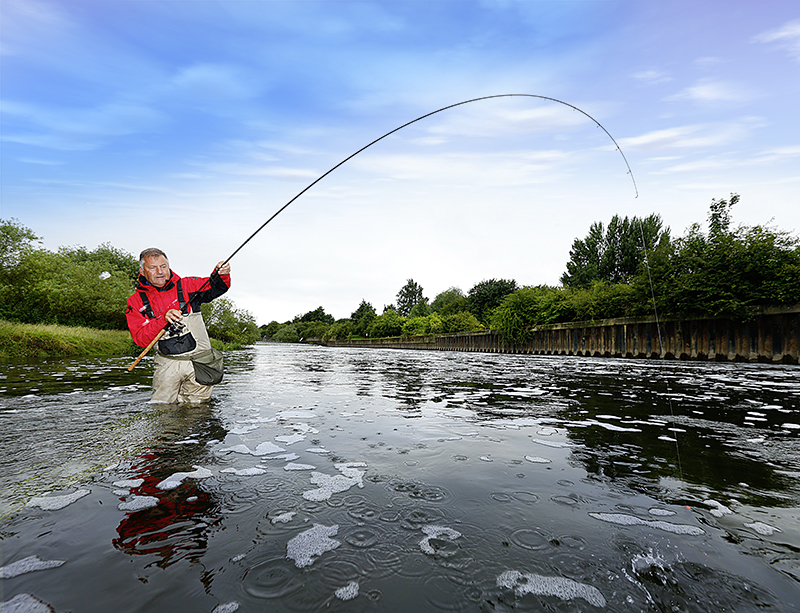Daiwa Powermesh Carp 12ft 3lb test curve review
After around 20 years away, Daiwa’s iconic Powermesh carp rods have returned to the fold.
Seven models span three 12ft rods with 2.75lb, 3lb and 3.5lb test curves. There’s also a distance-casting 13ft, 3.5lb rod, as well as Spod, Floater and Stalker versions, so all bases seem to be covered!
The Powermesh heritage is still spoken of in hushed tones by carp anglers of a certain age, although the new breed are a far cry from their classic namesakes.
These latest rods are slimmer, faster and considerably lighter than the old-school favourites. The one thing they still have in common with the classic Powermesh rods is unbridled power – but more of that later!
Clearly Daiwa, currently designing and constructing its best-ever carp rods across all price points, hasn’t skimped on materials and furnishings for its latest Powermesh offerings.
The slimline blanks boast a strengthened high-grade woven carbon build. When called upon to do so they serve up more than enough casting power for long-distance and PVA bag work.
The astonishing parabolic fish-playing action, as you can see from the image, tightens up quickly across the rod’s mid-section so you’ll stay in charge when faced with hard-fighting big fish in snag pit swims.
As to fittings, these new Powermesh rods are finished to a very high standard, incorporating original Fuji DPS reel seats, slim profile shrink grip handles, stainless steel frame guides with lightweight LS ceramic-lined rings (including a 50mm butt guide) and an aluminium butt cap.
With ‘demanding situations’ a high live test priority, a trip to Oxfordshire’s Clattercote Reservoir was arranged. The big carp on this prolific runs water respond best to long-range solid bag and margin tactics, although the latter option is not for the faint-hearted. Rods need to be picked up and locked up fast to stop fish (as the Drifters sang) going ‘under the boardwalk’.
My choice of rod, the 12ft 3lb test curve Powermesh, can be found online as part of a ‘buy two or three’ package for as little as £84.99.
Now, you may be wondering why, when 3lb-plus tc rods are so popular, I chose the 3lb option. It’s quite simple really, and worthy of note if you’re a prospective customer. Having handled the entire new Powermesh range last October, I felt the 3lb rod was at least the equivalent of a standard 3.25lb or even 3.5lb Daiwa model.
What’s more, having now fished with the rod, I am qualified to say that it’s a fair bit more pokey than its rating would suggest.
That’s almost certainly down to its crisp action rather than its test curve, but bear it in mind if you’re looking to buy a set.
That is a course of action you shouldn’t miss out on if you’re in the market for a set of quality, high-performance carp rods at a sensible price.
They cast brilliantly, will play the biggest of fish superbly well and, I may add, would make awesome French kipper weapons.
Our verdict: The new Powermesh carp rods have enough grunt to safely cast the heaviest of leads, and will outcast virtually all other carp rods in their price bracket.
The fish-playing action is unrelenting, putting you in control at all times – these rods are worthy inheritors of the iconic Powermesh name.
Price: £169, but shop around and look on the internet for multiple deals
Sonik SKSC Commercial Feeder 10ft Review
The Sonik Sports brand is very familiar to pursuers of big carp, less so to commercial match and pleasure anglers.
All that is set to change, though, as the company is about to introduce an impressive new rod collection dubbed the Sonik SKSC commercial range.
The six rods comprise 9ft, 10ft, and 11ft Commercial Feeder rods, and three Pellet Waggler rods in the same lengths.
I’d originally intended to live-test a matching pair for both disciplines, but a recent spell of cold weather had well and truly put paid to fishing up in the water using pellet waggler tactics – so it was a case of feeder or bust. I chose the 10-footer.
However, before we move on to the bank, let me tell you a bit more about Sonik’s new SKSC range.
The rods have been thoughtfully designed, and are nicely constructed to meet the basic needs of the pleasure or match angler. They have modern, progressive fish-playing actions with plenty of backbone, making them ideal for commercial carp – a bit of added steel provides enough grunt to tame the odd zoo creature.
The slim, two-piece equal-length blanks are built from a high-grade 24 tonne carbon cloth and furnished with quality titanium oxide lined guides and a screw-down reel seat with EVA thumb grip. The decent length handle is a cork and EVA combo.
I’ve left the best bit till last – the price. If you want performance on a tight budget, you’ll need to fork out just under 40 quid!
So, what’s the rod capable of? It’s the ideal tool for short to medium-range casting, comfortably chucking 45g weights 40 yards-plus. Anything more and the rod will start to overload, which affects distance and accuracy.
It will handle mono reel lines between 5lb and 10lb, and can be safely used with hooklengths down to 0.12mm and hooks as small as an 18.
I kicked off the live test at Horseshoe Lake on Steve Gregory’s Rushfield complex, using a 30g flatbed Method feeder loaded with micro pellets, and a banded 6mm pellet hookbait – which proved to the liking of a string of stockie carp and F1s.
Although bites were at times quite savage, the fish responsible for whipping the rod’s top section round were at best bantamweights. However, I can happily report that nothing came unstuck as I quickly reeled them in – the 10ft SKSC has more than enough tip cushioning to deal with smaller fish without pulling hooks, even when you’re bagging.
A change to a lighter feeder, so as not to spook the fish, and a larger 8mm pellet hookbait cast down the margin, came up Donalds!
Two commons, one just over 10lb, put a serious bend in the rod, allowing it to show its full fighting curvature.
As you can see from the brilliant image captured by Angling Times staff photographer Lloyd Rogers, all the power in the rod is loading from just above the mid-section area, proving the blank’s steely resilience. In my book, that makes it the ideal commercial carp Method feeder rod.
Price: £39.99
SHAKESPEARE AGILITY 2 11ft PELLET WAGGLER
Ever since pellet waggler tactics evolved to help anglers catch more and bigger carp from commercial waters, Shakespeare has had a top-selling rod for the job out there on the market.
Shakey’s award-winning Mach 3 XT Micro Pellet Waggler, for example, was a cutting-edge tool of its time, to be found in the holdalls of pleasure fishermen and matchmen of every skill set.
The tactic has stayed much the same over time, requiring a repetitive ‘feed, cast, feed’ sequence. Any changes revolve mainly around the type of venue we are now targeting, rather than anything more fundamental with the tackle itself.
Larger open-water venues such as Boddington, Larford, Barston and Meadowlands require longer, stiffer-actioned rods that will cast heavy floats and pack enough punch to play and subdue big fish.
Smaller commercial venues, such as snake lakes and 20-peg pint-sized pools pools, tend to be tackled with shorter 9ft, 10ft and 11ft rods, many of which are two-piece graphite blanks with a non-locking progressive action.
Even so, these can feel that bit heavier in the hand, and are not quite as quick at their tip-ends as all-carbon rods when it comes to lifting line from the water.
All this brings me nicely to this week’s live test rod, Shakespeare’s second generation Agility 2 Pellet Waggler 11ft, which is as close to an all-round pellet waggler rod as you’d wish to find.
At a push it will mix it up with heavier floats and big fish, while at the other end of the scale it can be used with small hooks and light floats for winter F1 fishing.
The live test at Decoy’s Beastie Lake proved the rod’s all-round mettle. I started in an open-water peg using 6lb mainline, a 0.17mm hooklength, size 16 hook and a 6mm banded pellet, all suspended beneath a hefty 10g pellet waggler to combat a nasty side wind.
Trying to keep the float still long enough to attract a bite proved nigh on impossible, and from experience I know that carp (no matter how daft) will not chase down a hookbait being dragged sideways across a swim!
So, despite my best efforts, all I had to show for an hour’s fishing was a couple of F1s, whose appetite obviously outweighed their intelligence. However, despite that niggling easterly, the rod cast the float straight and true and fairly whipped line from the surface on the strike.
A move to a quiet corner with a small island opposite proved just the ticket, and a much lighter 3AAA float proved no problem to cast for the Agility 2 Pellet Waggler 11ft. The rod’s reduced length handle is easy to manoeuvre around the body when feeding with one hand – an essential attribute – and the blank is impressively light and comfy.
Casting range I would put at 40m tops with a 15g float, that being as heavy as I’d want to chuck around with this rod, although Shakespeare does give it a 30g maximum casting weight.
Line pick-up speed is quite exceptional, thanks to its all-carbon build and fast taper design.
Seaguide double and single-legged stand-off lined guides, a quality cork and EVA handle, secure screw-down reel seat and a keeper ring add to the joy of fishing with this rod.
Its progressive, not to say slightly tippy, action gives it plenty of grunt, and helps make it an absolute pleasure to use.
Our verdict: It never fails to amaze me how Shakespeare has this happy knack of pulling something a little bit special out of the bag every year. The new Agility 2 Pellet Waggler 11ft looks, feels and performs every bit as well as rods costing three times its asking price. Slim and very light to hold for long periods, it makes easy work of feeding with a catapult. A viper-fast strike speed will help you connect with equally rapid F1 bites, even a respectable casting distance away.
Price: £84.99


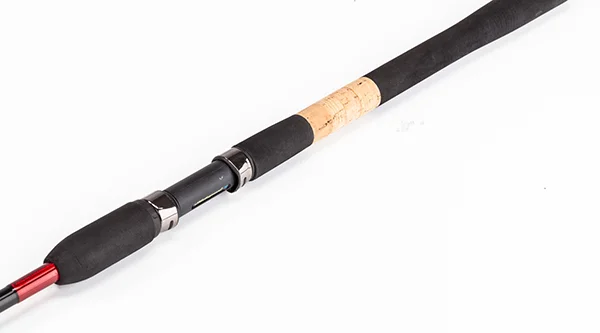
BROWNING HYPER CARP METHOD RODS review
Just before Christmas I was privileged to visit Browning’s German HQ and give their four new Hyper Carp Method rods a waggle.
Right away I felt these would be perfect for commercial fisheries back home, although at the time Browning seemed uncertain whether they would be available in the UK. However, I banged on and on to the company to release them, and to send me a couple of samples in for a live test. These the makers eventually did, so now I can deliver my verdict.
Now, Browning’s Sphere feeder rods are among the best money can buy, and these Hyper Carp Method rods are not a poor man’s version of these. They have an altogether different feel and action. There’s enough flexibility in the blank to pan large skimmers and bream without fear of hook pulls – the cushioning effect kicks in high up on the second section. This gives the mid-section a good deal more backbone, which you’ll really appreciate when the rods are being stressed to the limit.
All this and more I was to discover at Clattercote Reservoir, whose resident carp were wide awake and raring to go. My chosen rod from the Hyper Carp Method range was the 12ft version, which I reckon to be the pick of the bunch. With an 80g maximum casting weight, it has the length and three-piece build specification to launch a flatbed Method feeder a very long way. In my hands, however, it felt most at home with feeders up to around 40g.
The guides (including those on the quivertip) have sufficient inner diameter to allow the safe passage of 10lb shockleaders, which you need on most feeder venues requiring a mega-chuck.
Well, I hear you say, there are already dozens of long cast feeder rods on the market. What makes these from Browning so special?
For a start, the Hyper Carp Method will cope with all sizes of carp with some style, yet has enough flexibility to stay in touch with bream and skimmers right up to the net. Distances of 80-100 yards can be reached without you needing to be a tournament caster! And the price is remarkably reasonable for what you get.
The live test, I’m relieved to say, proved that the Hyper Carp Method rods are every bit as good as I’d hoped, and then some.
Once I got used to the blank’s fast taper action I was hitting the reel clip with a loaded 30g feeder at around 80 yards every time from a seated position, while standing up and giving it a proper whack I was getting past 90 yards. That was using a 4000 sized reel without a shockleader. I was left wondering how much further I could push its muscular cousin – the 12ft Hyper Carp Method Distance rod, with its £149 price tag – if it were fitted with a big reel and a shocker! This beast will chuck a 100g feeder with ease.
Back to the rod on test, and its fish-playing action proved remarkable. Even when subjected to huge pressure from proper lumps it showed no signs of locking up. After a few bream had put in an appearance not a single fish of either species was lost – which, as any Clattercote regular will tell you, is impressive.
Our Verdict
The Hyper Carp Method is the best rod of its kind and at its price that I have ever handled.
Okay, the multi-banded Euro colours of the quivertips may not be to everyone’s liking. But I’ll tell you this – you certainly can’t miss them which, to be fair, is the general idea.
This was one of the best live test days I have ever had, made even better by the presence of Mark Eves and Phil Ringer, who are highly entertaining, class angling acts.
Price: £139 (but shop around and you’ll find it cheaper)
Hyper Carp Method rods from Browning
In a recent trip to Browning’s impressive HQ in Germany I was shown a range of Method feeder rods not originally designed or intended for the UK market.
However, their pedigree says otherwise. Start with a fast-taper, high modulus carbon build, giving a flat spot-free and progressive fish-playing action.
Add an array of impressive fitments such as graded push-in carbon quivertips and perfectly spaced lined guides capable of being used with shockleaders.
Top that off with long cork handles that generate the power to propel a feeder an awfully long way. No wonder it quickly became apparent that these rods were spot-on for the senior inhabitants of our commercial fisheries.
Happily, I am able to report that after a re-think by Browning, the quintessential big-fish quartet of Hyper Carp Method rods are now available here in the UK in lengths of 10ft, 11ft and 12ft.
A souped-up 12ft distance casting model is also available.
Their eminently affordable pricing should appeal hugely to anyone fishing matches or enjoying pleasure sessions at venues such as Boddington, Larford and Clattercote – in fact any open expanse of water holding decent-sized fish.
Watch this space for the exclusive live test next week on these superb new Method rods. Going from shortest to longest, maximum casting weights are 2oz, 2oz and 3oz, with 3.5oz for the Distance model.
Price: 10ft £125, 11ft £129, 12ft £139, 12ft Distance £149
Drennan Red Range Carp Feeder/Carp Waggler rod and Method Feeder/Pellet Waggler rod
Drennan's introductory Red Range rods are comfortably affordable, well-appointed and perfectly designed for the job in hand.
That said, I was somewhat perplexed when the two latest family members – the Combo Method Feeder/Pellet Waggler and Combo Carp Feeder/Carp Waggler rods – arrived on my desk. As first glance the pair, finished in Drennan’s trademark burgundy colour, looked like Tweedledum and Tweedledee – identical twins.
What’s more, it wasn’t that many years ago that combination rods only graced the sports pages of your mum’s Kays or Grattan catalogues. Such ‘one rod does it all’ tools were hideously heavy, multi-sectioned and multi-handled affairs, claimed to be suitable for everything from fly-fishing for trout to boat fishing for pike. In reality they were useless for everything.
Thankfully, such horrors are well behind us. Modern-day combo outfits are mainly well thought-out, intelligently designed and fully usable for all their stated applications. Most importantly, they are affordably angler-friendly, and all these praises can indeed be heaped on the Red Range Combo pairing.
As you’d expect from Drennan, both rods are very nicely furnished with lined guides throughout, secure screw-down reel seats, hook keeper rings, and a single push-in glass quivertip – 3oz for the Carp Feeder and 4oz for the Carp Method.
These rods are clearly targeting novice and junior anglers with limited tackle knowledge, and yet choosing between the two could be a confusing process. So, having fished with both, allow me to state the differences between them.
The Method Feeder/Pellet Waggler Combo has a bit more power, and is ideal for big fish using heavier kit. With its feeder top section fitted it will easily handle 30g-plus Methods, while with the Pellet Waggler section fitted it will cast floats weighing up to 15g.
The Carp Feeder/Carp Waggler model has a lighter action, suiting it to maggot, pellet, open-end and small flatbed feeders.
Fit its waggler top and it will cast floats upwards of 4AAA, offering a little bit more tactical flexibility.
For the live test, I decided on a joint appraisal, setting up both Combo models – the Carp Method in feeder mode and the Carp Waggler as a float rod. The chosen venue was the ever-productive Stretton Lakes just north of Peterborough, just two minutes off the A1.
The carp lake here holds decent-sized fish, and while it’s not as easy as your normal commercial day-ticket fishery, the carp here are always scale- and mouth-perfect, and fight like demons.
The Carp Method Combo with a 30g flatbed loaded with micro pellets has a maximum casting range of around 60 yards. Much further and you are going to lose some accuracy. However, once a fish is hooked the blank has a resolute flat spot-free progressive action, with enough backbone to give double-figure fish nightmares. I’d suggest reel lines from 5lb-10lb, matched to hooklengths of 0.15mm upwards.
The Carp Waggler Combo has just about enough tip flexibility and whip to cast normal straight wagglers carrying 4AAA or more.
The blank’s soft, semi-through action makes it ideal for taking on smaller carp and F1s, as well as tench, chub and big bream, using reel lines from 4lb-8lb and hooklengths of 0.14mm and beyond.
Our Verdict: These latest additions to Drennan’s Red Range are sure to be hugely popular with the solar-powered pleasure angler.
If you are reading this as a tackle shop owner, and you get a potential new customer that wants to have a go at commercial fishing, or someone on a tight budget looking to invest in new rods with commercial fishery potential, than I doubt there is anything better than this pair of beauties currently on the market.
Price: £85.95 (both models)

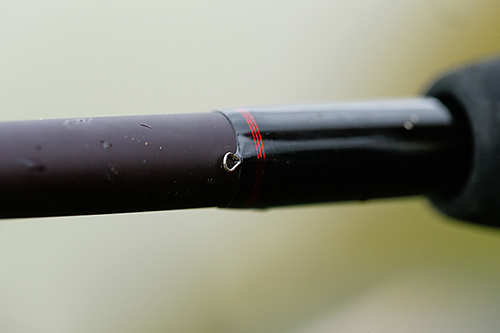

DAIWA CAST’IZM 12ft 6ins FEEDER ROD
Now here’s a thing… what do you get if you cross the world’s best feeder angler with the world’s best rod manufacturer? The answer? Cast’izm.
That, for those of you who have had your head stuck in a groundbait bucket for the past month or so, is the name of the new feeder rod range designed by Steve Ringer and manufactured here in the UK by Daiwa.
These all-black beauties kick off with an 11ft 6ins rod capable of casting up to 60g (2oz) and suited to open-end and pellet feeder work, as well as a straight bomb. It will handle commercial carp and silvers with equal panache.
The 12ft 6ins version (on live test duty) is Mr Ringer’s favourite, very much at home on large, open bream venues such as Ferry Meadows and Bough Beech.
Its 80g (3oz) casting band is well capable of handling Method and Hybrid feeders.
After those two come the ‘big boys’ of the Cast’izm range, both really long-distance casters.
The 13ft 6ins rod can handle 100g (3.5oz) and is claimed to chuck more than 100yds, suiting it to rocket and window feeder work where every inch of distance is important. Natural venue species and commercial carp are meat and drink to it.
The biggest Cast’izm, 14ft 2ins long and with a maximum casting weight of 120g (4.2oz), is ideal for big rivers such as the Trent and Severn, and I suspect it will go down well with those who fish matches on the wide and deep canals of the Netherlands.
Despite their reasonable price, no corners have been cut with the Cast’izms. Their latest HVF Nanoplus carbon construction imparts a clean, crisp action, and a rapid tip-end recovery speed adds yards to the cast.
The three-sectioned models all have a carrier section, and to prevent any flat spots at the joints Daiwa has employed its unique V-Joint system that retains seamless and progressive curvature at all times.
Large-diameter K guides help to prevent tangles and speed the passage of line. Interestingly, the three carbon push-in Tournament Distance Tips are graded to match the rod’s capacity, although other test curves are available too. These are exactly the same tips as used on Daiwa’s top-end SLR rods. Enlarged ring diameters prevent tangles and possible crack-offs, and their wide spacing contributes to casting performance.
As for the live test itself, the only thing in plentiful supply was the rain. I knew full well that Ferry Meadows, near Peterborough, had been in poor form since last September but, after all, this is exactly the kind of place these rods are designed to be used at.
The 12ft 6ins Cast’izm fairly sizzled out every breed of feeder known to man. Matched with the right sized reel, it’s a lean, mean casting machine that loads the weight of the feeder high on the blank to keep pre-cast bounce to an absolute minimum. What it’s like to play a fish on I can’t say, as that bit didn’t happen.
As Arnie said: “I’ll be back”… later in the year, when it’s warmed up a bit, and the bin lids are lifting.



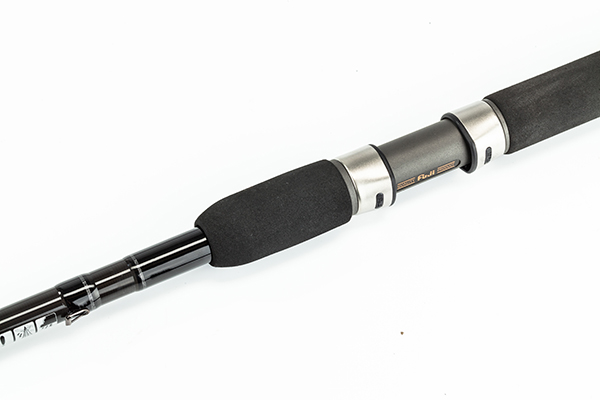
Our Verdict:
These four Cast’izm rods make up possibly the best long-range feeder quartet on the planet. The design influences of a world-class angler are clearly visible.
The right type of guides, and extra spacing between the rings on the carbon quivers, provide fluid casting power. The longer handle gives added speed through to the tip, so even if your casting action is a bit on the slow side you’ll achieve longer distances.
A progressive mid-section action makes the use of reasonably small hooks and lightish lines possible without fear of lost fish.
But there’s still enough severity in the the butt section to deal out punishment to big commercial carp.
What’s not to like? This is a rod fabulously designed and brilliantly built for use anywhere, for everything.
Price: £169.99 (12ft 6ins version)
Matrix Horizon 10ft Carp Feeder rod Review
Matrix says its new Horizon Carp Feeder rods were developed to cope with the ballooning size of carp in modern match waters.
Mark Pollard has had lots of input into the design of all four rods which, despite being as strong as Shire horses on steroids, deliver a progressive action.
There are 9ft, 10ft (on test) 11ft and 12ft versions to choose from, depending on how far you want or need to cast. One thing in common to all is three graded push-in carbon quivertips of 1oz, 1.5oz and 2oz test curve.
The fast-taper high modulus carbon blanks are quick off the blocks when it comes to line pick-up and casting accuracy.
All have equal-length sections for ease of transport, a uniquely detailed weave print on their butt sections and decent length cork and EVA handles. Incorporated into these are screw-down reel fittings, while the blanks are furnished with low-profile ceramic-lined guides and a keeper ring as a finishing touch.
The 10ft Carp Feeder, my Horizon rod of choice for live test duty, is primarily a tactically flexible feeder and straight lead tool and, as such, is likely to sell well. There’s no maximum recommended casting weight, but by my reckoning you’d be safe with anything up to 40g.
The same goes for the line rating (or lack of it), but again, for me, anything between 4lb and 8lb would be fine – just the job for any commercial fishery whose carp have failed to sign up for Weight Watchers.
I needed to get the Horizon Carp Feeder rod to a water where bites come readily to a variety of tactics, so where better than Buttonhole Lake near Wisbech, in Cambs?
A swim opposite a paddle aerator gave me something to aim at in open water, while a large island away to my right would challenge the rod’s distance-casting prowess.
A standard inline 30g flatbed Method feeder flew 30 yards arrow-straight and bang on target. Once I’d clipped up, I reckoned it would hit 50 yards with just a bit more ‘push-pull’ on my part, but around the 40g mark the rod began to show its casting limitations. However, towards the end of the session I was still chucking a 30g feeder a good 65 yards-plus. On commercials that’s equivalent to hitting a six out of the ground at Trent Bridge!
What the Horizon has going for it is a superb action, which has obviously come in for some serious scrutiny and field-testing from the Matrix consultancy team. Sweet as a nut, back of the net, and more fun than a day at the fair, it’s just perfect for the job.
The rod bends exactly how, when and where it should, and has more than enough backbone to heave a reluctant lump over the rim of the landing net.
As you can see, this beast gave me a proper run-around, especially when it tried with all its might to get its head underneath the platform.
I don’t need to say much more about how flexible a backbone this rod possesses – look at the image and drool at its fast, progressive fighting action.
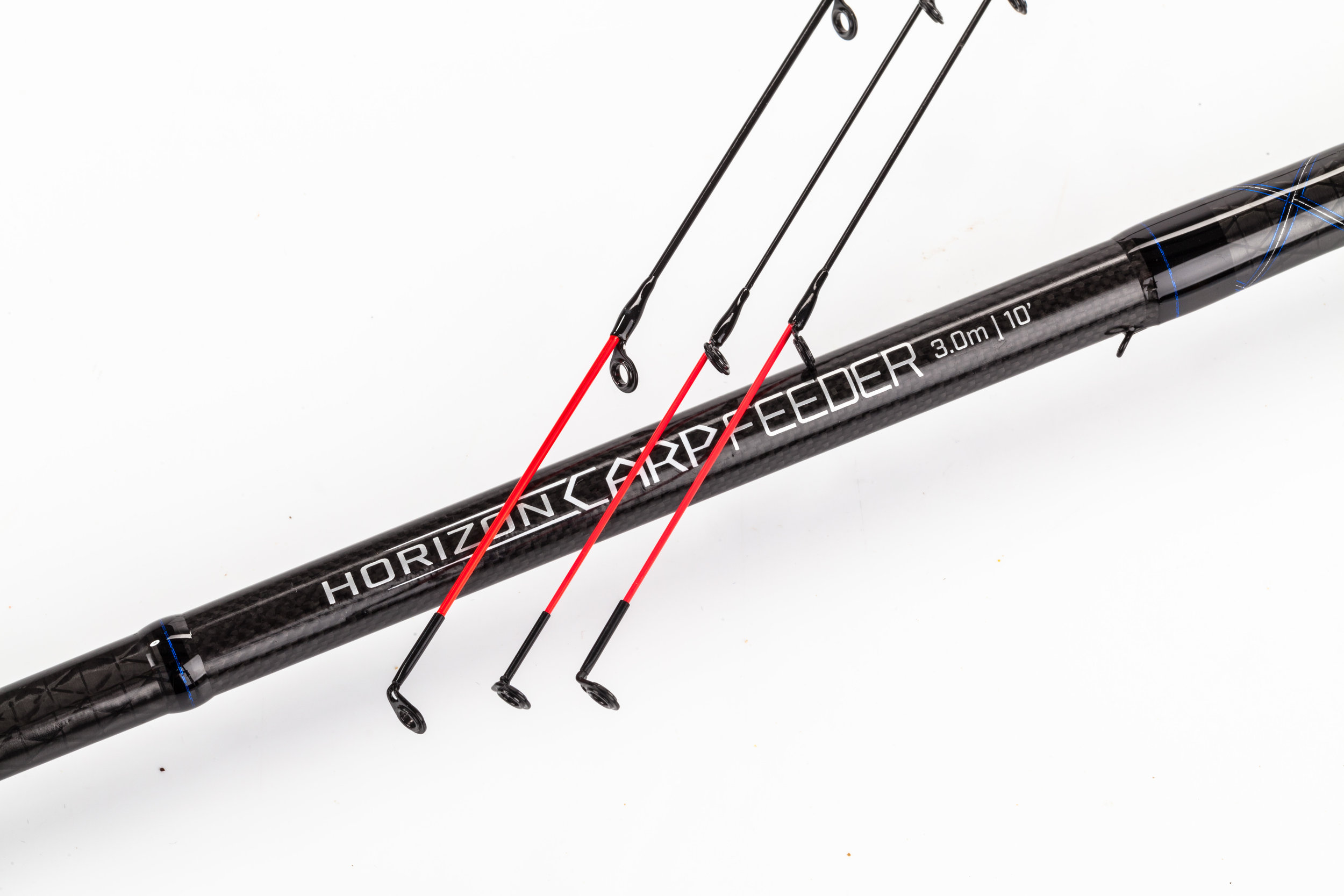

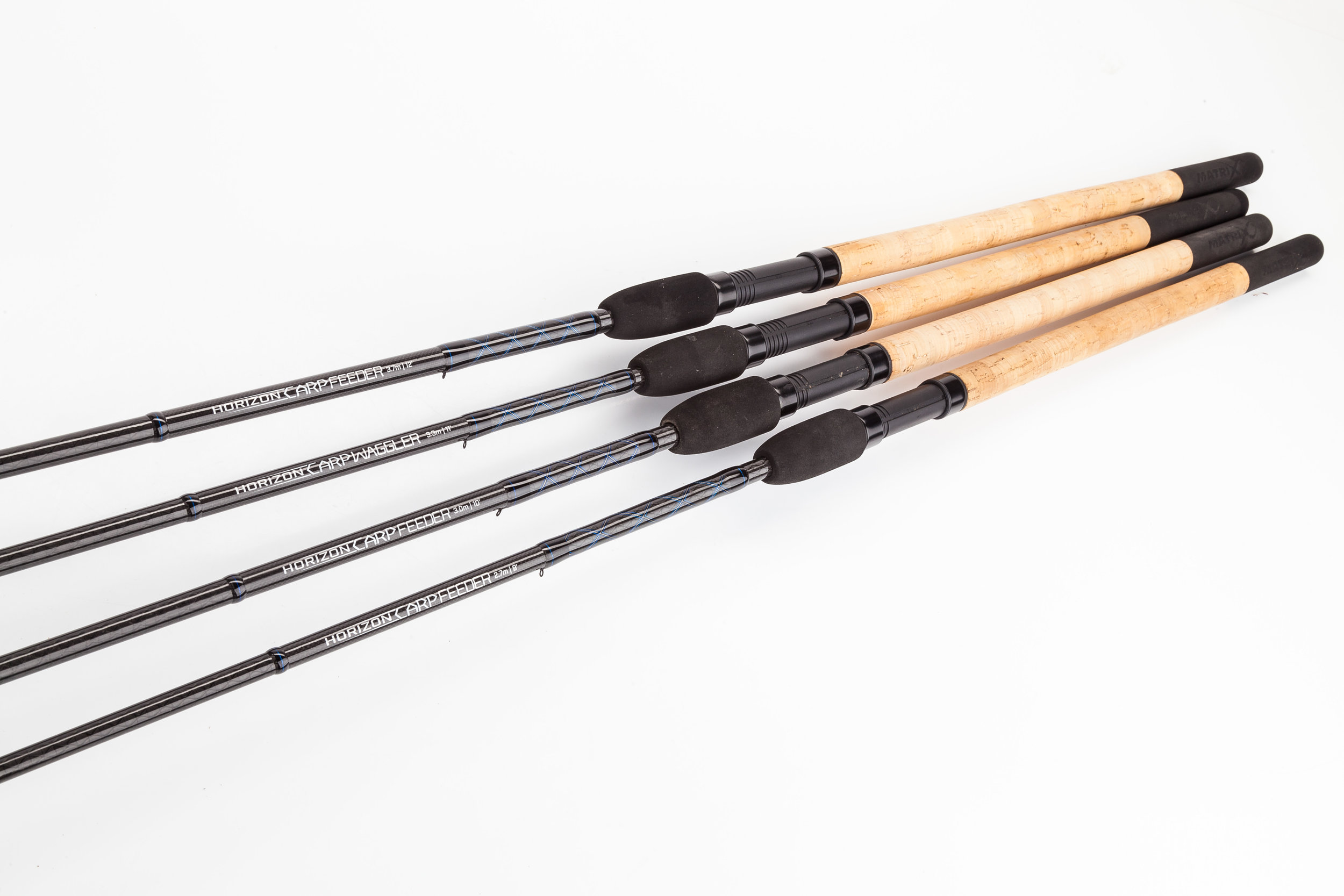
Our Verdict:
The latest Matrix Horizon Carp Feeder rods look, feel and fish just right, with a very high overall level of performance.
On the commercial fishery front, they have just about enough flexibility to be used for carp of all sizes, plus big F1s.
The 10ft model is ideal for Method, maggot and pellet feeder work, and would be equally at home throwing straight bomb set-ups for bigger fish.
It’s worth noting that all the Horizon quivertips are interchangeable with those on Matrix Horizon XC and XS models.
Price: £139
Stillwater shuriken rods review
Online tackle retailer Chapmans has produced quite a few decent rods under its own Stillwater brand since its inception.
But it’s fair to say that most have majored on economy rather than performance. Until now, that is!
Chapmans, in partnership with Daiwa, has just released an 11ft Pellet Waggler and a 10ft Mini Method Feeder rod under its new Stillwater Shuriken banner – and the pair fairly sizzle in terms of build quality, performance and quite astonishing value.
Both are made from slim, equal-length two-piece carbon blanks of some distinction. The 11ft Pellet Waggler is rated to reel lines up to 8lb, and designed for carp and F1 fishing. The 10ft Mini Method Feeder will handle 40g feeders, and comes with 1oz and 1.5oz push-in carbon quivers.


Key furnishing features on both include pleasing all-cork handles, aluminium oxide lined guides, classy gloss black whippings, and a keeper ring as a nice final touch.
And it doesn’t stop there, as I found out while live testing the wonderfully named Shuriken (pronounced ‘Shirken’) room-mates at Decoy’s icy cold Lou’s Lake. Happily, while one side of the horseshoe-shaped water was solid with ice, the other, where I was fishing, gave more than a fair impression of a balmy August afternoon, rather than a bone-chilling mid-February freeze.
But enough of the weather – let’s take a closer look at the Shurikens. It wasn’t until I got the rods back home and started delving into their construction details that I was even aware that Daiwa had a hand in their creation. However, within a couple of minutes of using them, I recognised that unmistakable steely ‘Daiwa feel’ running through the mid-sections, making them more than a match for the largest of commercial fishery denizens as well as pasty-sized stockies and F1s.
Not that these two rods are in any way cheapo whopper stoppers – both sport a quite superb and sweetly progressive action.
The seven white-tipped whippings on the 10ft Mini Method Feeder quivertips are brilliant. Regular readers will know of my dislike for quivers with anything other than a daub of blaze or orange paint on their ends. But I must admit that my attention was mesmerically drawn towards the white whippings, making missed bites very unlikely.
The 11ft Pellet Waggler has a very similar progressive action to its stablemate, but the tip-end is very slightly softer, giving it more whip and making it easier to cast light floats – in this rod’s case from around 4AAA (3.5g) upwards.
My first carp of the year on the float fell to a corn skin bait, set 3ft feet deep and cast tight against a line of Norfolk reeds – basically the waggler equivalent of dobbing.
Given the size and fighting spirit of the fish caught, I can certainly vouch for the power in reserve that still has enough cushioning to permit the use of reasonably small hooks and light hooklengths.
Price: £49.99
Our verdict
What's not to like about this pair?
The fact that you can buy both Shuriken rods for less than the price of a top-end feeder or pellet waggler weapon makes them a real steal.
Ideal for all but the largest of commercial fisheries, they have impressive fish-playing and casting actions, are very nicely furnished and fitted out, and combine good looks with an equally good performance.
Sonik Vader X carp rods
tech spec
- Slim, lightweight matt black carbon fibre blank with progressive casting action
- Double leg black SiC guides and anti-frap tip ring
- 50mm butt guide on all 3lb tc models and above
- Fold-friendly ringing patter
- 17mm black DPS reel seat to house the largest of big pit reels
- Line-friendly custom contoured Sonik line clip
- Slim Japanese shrink-wrapped butt grip
- Black anodised butt cap, laser etched with Sonik’s ‘S’ logo
It's said that you only ever get what you pay for, and 99 per cent of the time this is true – especially with fishing equipment.
But occasionally something goes against that old adage by offering true value for money, matched by a performance to enthuse over.
Take Sonik’s excellent and affordable Vader X carp rods. They start at just £64.99. For that small sum you might expect a budget composite material with an action either poker-stiff or more wobbly than jelly on a plate. Not a bit of it!
The bang you get for your buck is a slim, light, carbon fibre rod, tastefully dressed with high-gloss black whippings over a non-flash gunmetal grey blank. Double-legged black SiC lined guides are fitted throughout, starting with a 50mm butt ring and ending with an anti-frap tip ring. There’s also a dependable 17mm black DPS reel seat to take big pit reels.
Subtle white graphics, a slim Japanese shrink-wrapped butt grip and a custom contoured Sonik line clip all add up to a rod that wouldn’t look out of place on carp venues of the utmost cultishness!
The 12ft, 3.25lb test curve model on live test duty can be used for everything from Method feeder to solid PVA bag work. Other rods in the Vader X range include 12ft (2.75lb and 3.5lb), 13ft (3.5lb) and a rather handy 4.5lb test curve hybrid Spod and Marker rod.
Although pitched by Sonik as a medium-to-long-cast tool, the 3.25lb tc model can be used for close-range and margin work too.
During the live test it easily chucked a 4oz lead more than 75 yards. This is quite a pokey blank, but unlike many of today’s ‘value for money’ carp rods this one retains sufficient cushioning in its progressive action to absorb the lunges from big lumps without risking hook-pulls. Use it with Method feeders, PVA sticks, solid bags, or straight leads up to 4.5oz.
Price: £74.99
Verdict: Sonik Vader X carp rods are very decent medium to long-range big-fish tools. Ideal for the novice carp angler, they are well built and nicely furnished, with an action perfect for pits and lakes where distance casting is paramount.
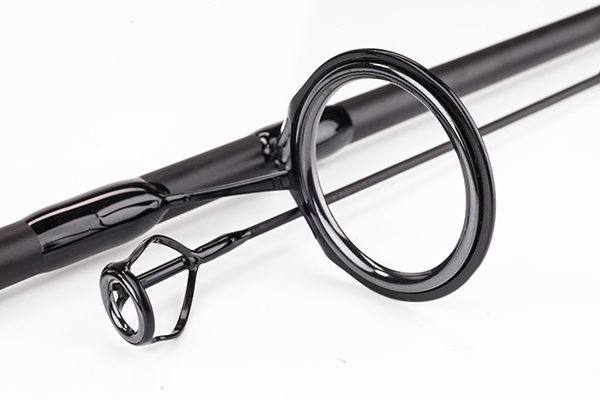
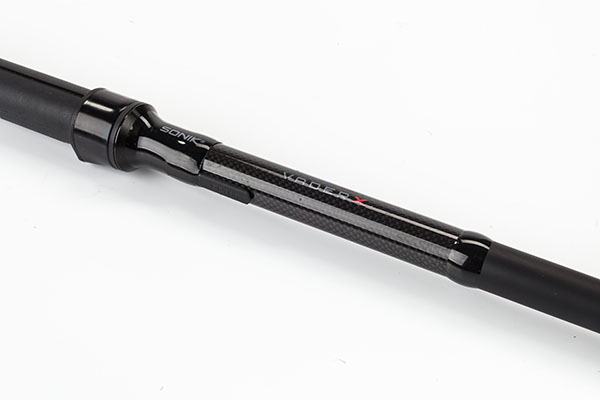
Preston supera 10ft Pellet Wag Review
Preston Innovations bills its Carbonactive Supera range as the ultimate all-round rod collection.
The eye-catching ensemble, in a jet black gloss finish, features short 9ft and 10ft feeder rods – the 10-footer stepping up for live test duty – as well as 11ft 6ins and 12ft 6ins models. An 11ft pellet waggler rod completes the set.
And if you think that little lot favours feeder over float, remember that these days feeder rods outsell their floatfishing counterparts by at least six to one.
My initial thoughts were the four feeder rods shared a softly progressive, through action.
Soft blanks cushion against hook-pulls when targeting skimmers and bream, or chub and roach with small hooks and light hooklengths.
Followers of my Live Test slot might point out that I seem to be stuck in a bit of a rut right now, reviewing so many short feeder rods. In my defence, these are extremely popular for winter commercial tactics, offering pinpoint casting accuracy and an action perfect for dealing with F1s, stockie carp and the odd lump.
All this brings me nicely on to the live test venue – Stretton Lakes, just off the A1 halfway between Peterborough and Grantham. This peaceful and well-kept fishery has four day-ticket lakes that are more popular with pleasure anglers than matchmen.
The rectangular carp lake holds fish of all sizes, every one of them scale, fin and mouth-perfect.
These commons and mirrors show a definite taste for baits presented on a Method feeder cast to within half a rodlength of one of two small islands. This tactic tests a rod’s casting attributes.
In the 10ft Supera Feeder’s case they are just what you’d expect from a top-end Preston Carbonactive model – arrow straight. This rod will cope with up to a 30g loading, and its effective casting distance tops out at 35m-40m. Much past that and you’ll find your feeder or lead wandering off line.
However, any lack of distance-casting prowess is made up for by a seamless, non-locking action. This takes a bit of getting used to, but it’s something rather special.
The rod has a pleasing sense of transmission and ‘feel’ when dealing with your fishy quarry.
A new style of handle, with an enhanced EVA grip block on its end, provides a firm, non-slip grip, but that may well prove a Marmite moment for some.
To that you can add three graded, colour-coded push-in quivertips which all blend seamlessly into the carrier section without any flat spots, and top-end low profile lined guides throughout.
Price: £170.99
Verdict:
The new top-of-the-range Preston Supera 10ft Feeder rod is ideal for short-range commercial tactics, especially in swims just beyond a pole line. Build quality and furnishings are undeniably good. Casting flatbed Method feeders up to 30g with precision and accuracy is where it really scores, and its soft fish-playing action can see you land soft-mouthed fish that in winter can make all the difference between winning matches and becoming pools-fodder.
Maver MV-R 8ft Mini Feeder Review
If you’re a fan of short-range casting for carp and F1s, take a close look at Maver’s MV-R Commercial Mini Feeder rods.
The shorter, 8ft version has a wickedly fast progressive action that will propel any feeder or straight lead up to 30g around 35yds without too much effort.
Anything past this distance and you’d be better off using the 9ft version. At first the eight-footer feels a tad tippy, but it’s just the job for F1s and smaller stockie carp, minimising the likelihood of hook-pulls or snap-offs at close range. The rod is suited to reel lines from 4lb-8lb, and hooklengths upwards of 0.13mm.



The pencil-thin carbon blank breaks down into two 48ins sections with one of its three (½oz, ¾oz and 1oz) quivertips fitted. Match the rod with a small 2500/3000 reel and it’s all ready to go inside your holdall.
It makes things so much easier if you always carry a short feeder rod to your commercial peg.
All the colour had dropped out of the water at Decoy’s Willows Lake, venue for the live test, forcing the fish to shoal up tighter than normal in winter. However, a small maggot feeder, with a couple of maggots as hookbait, will always fetch a response from the odd F1 – you just need minimal feed and accurate casting.
I have to say I found the 8ft MV-R very much to my liking. It cast, as expected, straight as a die, and on a small platform it was easy to get into position without a lot of faffing around. Tippy it may be, but that suited me fine as I landed several fish up to about 3lb.
I have handled enough short feeder rods to know that this one has a steely enough backbone to handle much bigger fish. A wobble wand it certainly isn’t!
Price: £110
Verdict:
This rod is flat-spot free, with an impressive fish-playing pedigree to suit commercial waters. It would also make a handy summer margin Method tool.
It’s not cheap for such a short rod, but then, you always get what you pay for.
For me, a big plus point was the equal length sections, making it a doddle to transport ready made up in a carryall.
Greys Toreon Tactical Quivertip 11ft 10ins rod live test
Wth daylight hours reduced in winter, many anglers, myself included, much prefer to fish short sessions rather than spend days on end sat in a bivvy and carting mountains of tackle around.
It’s much more enjoyable to grab a rod, a net, a small rucksack and a couple of loaves of bread and wander the banks of your local river searching out a chub or two. The Greys Toreon Tactical Quivertip is the perfect tool for this. It's as versatile as a Swiss Army knife.
There are four lengths available in the range – 10ft 6in, 11ft 10in, 12ft 6in and 13ft – to cater for the needs of every stillwater and river coarse angler. They're just as much at home dishing it out on running water as they are bagging up at your local commercial or lobbing out a feeder on a large natural venue.
For this live test I’d chosen the 11ft 10in version, as at this length it’s a great
all-rounder. It’s just about short enough to creep into tight overgrown river swims, although if this is what you're primarily going to be using a rod for then the 10ft 6in model would be recommended.
This is also long enough to chuck a feeder to islands and open swims on commercials. Unlike most feeder rods, which come with two or three push-in tips, the Toreon Tactical Quivertip comes with five, ranging from 0.75oz to 3oz.
The rod also features a detachable butt grip which not only makes it more compact for storage, but also gives you two handle length options. There are nine lightweight gunsmoke SiC line guides on the rod and six equivalent guides on the five quivertips.
To test the rod I headed off to the tiny River Ise in Northamptonshire. This is a tributary of the River Nene and requires a stealthy approach at the best of times to avoid spooking the resident chub.
The fact that the water was fairly low and clear meant I’d have to be extra stealthy. Tactics were kept simple. My reel was loaded with 5lb mainline on to which I threaded a running link leger stopped by a buffer bead over a small swivel.
A piece of breadflake was pinched around a size 10 hook and cast into a deep pool between two shallow stretches of river. I'd baited the mouth of the pool and a couple of other spots along the far-bank reeds with a couple of small balls of mashed bread.
The first few spots didn’t produce a single knock, but a cast towards an overhanging tree saw the tip tremble before it pulled around in a classic chub bite.The fish was quickly steered away from the branches and, after a couple of jagged lunges, a small chub, was drawn over the landing net.
The next two casts produced a couple more chub of a similar size.
THE VERDICT
At almost £140 there are certainly plenty of cheaper rods on the market. But when you look at what you get for your money I think this rod is worth every penny. If you do a spot of river fishing, as well as the odd session on a commercial carp water, and enjoy feeder fishing for bream, it will cover the lot. And the range of five tips supplied with it really do make it suitable to a wide range of duties.
James Furness, Editor, Improve Your Coarse Fishing
TECH SPEC
Length: 11ft 10in
Pieces: Two
Tips: 0.75oz, 1oz, 1.5oz, 2oz, 3oz
Handle: Full cork
Reel seat: Screw lock
Guide type: SiC
Hook keeper: Yes
Drennan Acolyte 9ft feeder fishing rod
When it comes to rods, Drennan’s classy Acolyte family is right up there with the best.
The latest additions to the clan are these two delectable 9ft Feeder models that come in both Ultra (light-actioned) and the stepped-up Plus versions.
The pencil-thin, high-modulus carbon blanks come with three graded push-in quivertips, with all the furnishings and finishes you’ve come to expect to find on top-end Drennan rods.
Both versions are ideal for short-range straight lead and feeder work on natural and commercial fisheries.
TECH SPEC
•Best matched with reel lines from 4lb to 8lb (1.8kg to 3.6kg)
•Two-piece construction folds into a rod sleeve in seconds
•Neoprene rod socks also included
•Supplied with 1.5oz, 2oz and 2.5oz push-in carbon tips
•Extra tips also available
PAY AROUND
£169.99
WATCH THE VIDEOS
Korum twin tip plus rod review
As a keen specimen angler I find myself travelling to different venues in order to seek my chosen quarry. One week I might be tackling the strong currents of the River Trent for big barbel, while the next I could be sitting behind bite alarms on a tench pit.
These venues obviously require a number of different rods to cater for the different styles of fishing. Then of course you have to take conditions into account. Will the river be in flood? Does the lake require a long range cast? This common dilemma often means taking at least two different rods to the bank to cater for whatever conditions I’m faced with on the day.
It’s the reason I got rather excited when Korum’s new Twin Tip Plus rod landed on my office desk. It’s a rod that has been designed to give the angler the choice of fishing a different test curve without the need to buy more than one rod, and still enjoy all the quality and endurance of Korum’s usual high standards.
With its spliced hollow 1.75lb and 2.2lb top sections, it allows the angler to set up their rod according to the conditions, venue or species they’re targeting on the day and the user can always change over if, for example, they are feeling under-gunned.
Surely Korum already offers something like this in its current Twin Tip version, I hear you ask.
However, while those rods have been faithful servants to anglers over the years, they still ultimately only really offer the same test curve whichever tip you may change to.
Korum’s new product means that only the butt section is the same when changing tops, making it noticeably obvious to the angler that he or she has more or less punch.
The company designed the rod for multiple scenarios and species. For example, you could use the 1.75lb top section for float fishing for big fish on a river while the 2.2lb tip could be handy for casting out to 70 yards on a gravel pit for carp, bream and tench.
With its choice of two test curves, the rod will ultimately appeal to barbel anglers, though, and this is really where it comes into its own.
The proof, of course, is always in the pudding, so in order to fully test out the idea I decided I was going to sample the rod’s capabilities twice over.
In other words, instead of fishing just one venue, I was going to test out each tip on two separate venues to re-enact the common scenario as described above.
Normally, when I visit the River Severn, I will fish a rod with a test curve of over 2lb, but with few snags and the river running lower than usual, plus the fact I was fishing into the deep channel on the inside, I opted for the 1.75lb top.
I fished a scaled-down rig with small pellets to cater for the clear water conditions. It didn’t take me long to test out the rod’s action when a 7lb barbel ran off downstream with my hookbait. Pumping the fish back in the flow, the high modulus carbon blank performed excellently, bending right round to the butt but with enough power to get the fish in without disturbing the feeding fish in my swim.
Two more fish followed but it was soon time to test the other tip so my next port of call was some 120 miles away on a very narrow stretch of the River Nene known as Castor Backwater. Snaggy and full of features and, of course, barbel, I knew this would be the best venue to test out the heavier tip.
Again the rod came up trumps and handled everything I threw at it, as I landed a barbel of 5lb and a chub well over 4lb.
Mark Peck
13ft Drennan Acolyte Distance Feeder rod review
This is shaping up to be the year of the long-range feeder rod.
Most major tackle companies have either launched new models or added to their existing ranges.
The growing popularity of feeder fishing has spurred rod designers and product teams into developing models that will chuck leads to the horizon on big, open UK venues such as Ferry Meadows, Meadowlands and Barston Lakes, where bream and skimmers are match fodder but carp are also likely to be present.
Enter Drennan’s latest Acolyte family member, the three-piece 13ft Distance Feeder.
Drennan doesn’t hold with new rods that each boast its own specific casting distance or weight rating. Instead, in typical ‘ticks-all-the-boxes’ fashion, the company has taken its time to produce one rod that does it all.
The 13ft Distance Feeder has a crisp, responsive parabolic action, and comes nicely furnished with braid-friendly, low-profile double and single-legged SiC ceramic-lined guides.
You get an original Fuji DPS screw-down reel seat, full-length cork handle, and three bespoke carbon quivertips with test curves of 3oz, 4oz and 5oz. These have enlarged guides for the smooth passage of shockleader knots, eliminating the friction and congestion that at best will slow down the cast and at worst can lead to crack-offs.
The rod took shape over two years, and was tested on a wide range of venues by many top international anglers. Drennan says it’s ideal for use with 6lb-10lb mono or 0.8mm-0.12mm braid. It’s said to be able to chuck feeders and bombs to a maximum of 3.5oz (100g) up to 100m, if you have the necessary casting skills, of course.
With all that information under my belt, where better to run the rule over the new Drennan Distance Feeder rod than one of the best long-range bream venues in the UK – the currently out-of-form Ferry Meadows?
I’ll tell you now, as apart from catching a few ‘wasps’ and ‘skerrets’, the exercise was a complete disaster!
The un-breamy combination of sun and lack of wind was exacerbated by the annual Peterborough school holidays, which saw gangs of kids going afloat in a dazzling array of imaginative watercraft.
Most of the little treasures ended up thrashing the water to a foam directly above my carefully fed spot… bless ’em!
I can, at least, vouch for the Acolyte’s casting clout – it will chuck a hefty feeder a very long way, with unerring accuracy. My chosen spot was slightly to the left of a marker buoy around 70 yards out into about 8ft of water.
I was using a big cage feeder packed with groundbait, chopped worm, caster and dead reds, and once I’d got used to pushing through the rod’s fairly fast action I hit the clip firmly every chuck.
The blank lived up to its maximum casting weight rating of 3.5oz (100g), and anything over 50g positively sizzled through the rings.
However, you need to adopt a flatter, carp-style overhead casting action to launch heavier feeders and leads any distance, even though the blank will take them in its stride.
What I’d say about this very well thought-out distance weapon is that it takes some getting used to.
Don’t be afraid to give it a proper whack… its fast tip recovery speed and impressive backbone will withstand all the rigours and stresses of long-distance work.
Since the live test I have given the rod another outing and can report a good ‘feel’ through the blank, matched with pleasing mid-section sensitivity – ideal for bream and skimmer work. Nor did it let me down when the inevitable carp muscled into my swim.
Our verdict: another Acolyte winner for me from Drennan. Nicely put together, it’s very classy looking, with dependable fittings, and shows all the signs of having been designed and tested by those who know what to look for in a rod. I rather fancy it would make a quite superb summer barbel feeder rod, as well as a respectable tool for long-range winter carp, too.
Price: £229
Free Spirit Hi S Carp Feeder fishing rod
If fishing rods came with a pedigree, Free Spirit’s new Hi S Match rods would be pinnacles of the tackle trade aristocracy.
The company’s equally well-connected Hi S Carp rods have long been considered be the best that money can buy.
Free Spirit entered the match, pleasure, and specialist arena around three years ago with its mid-priced CTX range. But it was surely only a matter of time before match rods with the same top-spec build and quality carbon as the Hi S Carp rods entered the fray.
The comprehensive 16-rod Match range first saw the light at last year’s The Big One show, where those that saw them – me included – were wowed by their modern looks, quality fittings and almost frightening transmission of ‘feel’ through the blanks.
All are constructed from ultra-low-resin 40t carbon with woven butt sections. This makes them extremely light to hold, yet extremely strong.
The unique ‘Perdurable’ finish does away with paint or lacquer– it’s just the carbon, which is made to be ultra-resistant to damage and helps the rods to retain their showroom looks.
Hi S Carp Feeder rods (the 11ft version of which was on live test duty) are all fitted with high-end Kigan Z guides along the blanks themselves, while the quivertips bear anti-frap MZ rings that reduce the chances of the reel line or shockleader catching in them and causing a crack-off.
Something else that makes these rods that little bit different is their unique hollow quivertips. These eliminate any flat spots, since there is no abrupt transition from solid tip through to hollow blank – instead you get a seamless, progressive action.
To that lot you can add Fuji skeletal-style reel seats with a cut-away forward finger area, giving added feel and control when playing fish. Carp rod-style abbreviated handles allow easy directional changes when playing a hard-fighting fish close to the net, and ‘fold-friendly’ guide spacing allows you to break down a rod with reel and rig in situ.
Add all that up and you have to agree that Hi S Carp Feeder rods are a bit special.
Not only do they look classily different, they also feel and behave differently in the hand.
This was instantly apparent on the live test. The two-piece 11ft Carp Feeder rod is so slim in the butt section just above the handle – just 150mm in circumference – that it doesn’t look capable of casting a small float, never mind a feeder. How wrong can you be!
Not only will it chuck 3oz (85g) feeders with some ease, but it will propel them an awfully long way, certainly far enough to cope with most commercial venues.
The rod’s progressive action is equally admirable – the hollow quivertip gives it a seamless curvature, and it has enough power in its locker to cope with everything from F1s on light gear, through to big girls on heavy Method tactics.
The cut-away reel seat allows you to feel every movement of a hooked fish, and while the abbreviated handle may not be to everyone’s taste, it balances perfectly with the blank and is just the ticket for winding up a cast or piling on the pressure when it’s needed.
Mark Sawyer
PAY AROUND
£280 (abbreviated handle)
£300 (full cork handle)
Maver Reality 13ft Match Rod Review
Not so long ago a three-piece 13ft float rod would be standard issue for all match and pleasure anglers, and I’ll tell you why.
The industrial cities of Sheffield, Leeds, Rotherham and Birmingham gave rise to legions of angling aficionados (pardon the pun), many of whom worked in the nationalised coal and steel industries.
These had massive working men’s associations with affiliated angling clubs. Every weekend would see coach loads of fishermen arriving on the banks of the Witham, Welland, Trent, Severn and Thames, where float fishing with 13ft rods ruled the roost.
Those were the days, when fishing was basically the only recreation for many a working class bloke.
Tackle was functional first and foremost. Wicker creels, rods in canvas bags, Intrepid reels, Au Lion D’Or hooks, a handful of handmade floats – oh, and an Efgeeco baitbox containing a pint of ‘gentles’ in sawdust – was about par for the course.
The best float rods of the day were built mainly on fibreglass Golden Jubilee blanks, and appeared under the WB Clarke All-England, Milbro Enterprise and Billy Lane Match brands. The first carbon rods weren’t far away, though, although when Fothergill and Harvey launched them in 1975 they cost a king’s ransom at £133. Bearing in mind that back then a Mars bar cost sixpence (2.5p) and you get an idea just how expensive this rod was.
Thankfully, modern 13ft float rods are vastly cheaper in relative terms, as well as being better built, better balanced, lighter in the hand and an altogether superior product.
Enter Maver’s 13ft three-piece Reality, which can be found for as little as £49.99. It’s also available in 12ft and 14ft versions, and all three decent enough lightweight blanks with their medium-fast action will cast wagglers up to 25g.
Key features include a full cork handle with EVA lock-down foregrip, quality lined guides, folding keeper ring, and a classy jet-black glossy coating.
It’s not the crispest float rod I have ever come across, and it may lack a bit of finesse. But it can cope with whatever comes its way, as I discovered on the live test at Stretton Lakes’ day-ticket Silvers Pool, just off the A1 north of Peterborough.
I was hoping for roach with hopefully the odd better skimmer thrown in. Feeding groundbait laced with a few micro pellets and casters, my basic set-up saw a 3AAA straight peacock waggler attached to 3lb reel line, 0.12mm hooklength, and a size 18 hook with a double maggot as bait, fished overdepth.
Small roach and rudd gave me a bite a chuck, but these skerrets hardly tested the rod’s prowess. Bites then dried up, and I wondered if this was a prelude to the skimmers clocking in.
I didn’t have to wait long to find out. The float’s blaze top vanished and my strike was met with far more resistance than any skimmer could muster. The rod took on its full fighting curve in an action best described as on the stern side of progressive – pretty much what you need from a float rod if you’re likely to encounter bigger fish.
Eventually my balanced tackle got the better of a decent-sized carp, and what a handsome fish it was – bristling with indignation, it had clearly never been caught before.
The Reality Match had done its job, absorbing the carp’s every lunge without cause for concern. Yes, of course this rod was made to tackle silvers on rivers and stillwaters, but when it’s called to battle stations you’ll be glad to have it your side.
Our verdict: What's not to like about this rod? It’s very well priced, easy to use, feels reassuringly sturdy, and is ideal for all float work, trotting or static. As proved during the live test it also has a touch of steel about it, which means it will handle big fish with little hassle.
PAY AROUND
£46.99
Browning Black Viper Mk 2 13ft Review
The latest feeder rods bearing Browning’s Black Viper name are aimed more towards those who fish big open-water Continental venues than at your average UK commercial angler.
But did you really think I’d bother testing a rod of no use to anyone here in Blighty? Negative!
Within the range are three Black Vipers that I’m sure will appeal to the ever-increasing band of anglers who target bream, skimmers and even the odd carp on wide expanses of water such as Peterborough’s Ferry Meadows or Barston Lake in the West Midlands.
The trio in question are the 12ft 80g, 13ft 100g and 13ft 140g versions. In three sections, they are made from quality high modulus carbon fibre, and their good old-fashioned, slightly stepped-up action makes them deceptively powerful and accurate casting tools. This is especially true of the 13ft 140g rod being live tested (the 140g spec refers to the maximum weight it will comfortably cast).
All three rods perform equally well on still and slow-moving waters, and despite their fast action the carrier section is soft enough to enable the use of small hooks and lightish hooklengths without fear of fish losses.
This is a key factor when choosing a decent bream rod. You don’t need it to send cold shivers down your spine every time a proper bin-lid nods its head en route to the landing net, and in this respect the Black Viper is decidedly non-venomous!
In my book, Browning has been ahead of the game for the last couple of seasons in the design and construction of distance casting rods for bream. And regular readers of my tackle reviews will know of my fondness for the German firm’s outstanding (if rather expensive) top-of-the-range Sphere models. These are arguably the very best distance bream rods on the market.
Not that any of the Black Viper Mk 2 rods are the poor man’s Sphere – anything but, and with prices from £199.95 to £239.95 they will cause a sharp intake of breath as you hand over your hard-earned.
On, then, to the live test, and although the big-bream venue Ferry Meadows is basically at the back door of the Angling Times office it’s a tad out of form at present. Instead, a trip to Rysons Lake in Northamptonshire was hastily arranged.
This lake has two floating islands at around 65 yards and the fish drift between these. More often than not it’s a case of laying down a decent carpet of bait and waiting for the bream, which run to around 8lb, to turn up.
This tactic provided me with ample opportunity to test the rod’s casting accuracy and weight loading capacity. My large feeder packed full of groundbait, pellets, worms and dead reds weighs the best part of 4oz (113g), more than a decent test for a rod rated to a 140g maximum.
I got the feeling that the Black Viper was right on the line at 4oz, but that said, it went the distance. And once the feeding cycle was complete, it fairly sizzled out a loaded 35g feeder against the reel’s line clip.
Bites are detected via one of three supplied carbon push-in quivertips. The gaudily painted blaze and white tip ends may not be to everyone’s taste, but they show up well enough.
The real beauty of this Black Viper, though, lies in its ability to cast a long way and deliver a big soft-mouthed bream or skimmer safely back to you.
To that end it’s one sassy snake.
Our Verdict: Another absolute belter of a bream rod from Browning. Ideal for all stillwaters, I rather fancy that its casting prowess and cleverly cushioned softness will also endear it to those who line the banks of Norfolk’s River Yare every summer.
Sturdy low-profile Fuji K-guides, a full cork handle, and enlarged quivertip eyes (to allow for the smooth passage of shockleaders) combine to make the Black Viper Mk 2 another class act from the Browning stable.
Price: £239.95
Check out the video below for a closer look!
DAIWA 13ft Powermesh Specialist Float Rod Review
After around a 20-year absence, Daiwa’s iconic Powermesh rods are back with seven new Specialist models for the big-fish angler.
The full collection includes a bespoke two-piece barbel rod; 13ft, 14ft and 15ft float rods; and 11ft 6ins, 12ft 6ins and 13ft 6ins feeder rods with graded 1.5oz, 2oz and 3oz quivertips.
All are constructed from an identical high grade of reinforced carbon, the weave of which gives them that powerful, steely backbone we associate with the Powermesh name.
The rods are furnished to a very high standard, incorporating original Fuji reel seats, full-length cork handles and hard-wearing stainless steel frame guides with lightweight LS ceramic-lined rings.
To that little lot you can add a folding keeper ring, aluminium butt cap and a padded sleeve large enough to house a reel, so rods can be taken to the bank ready made-up.
With ‘demanding situations’ high on my live test objective sheet, a trip to a tackle-devouring stretch of the Trent was in order.
The river here is very shallow and clear, running fast over clean strips of gravel interspersed with waving fronds of streamer weed. You might just catch a glimpse of a pristine golden flank as a big barbel momentarily reveals itself.
As they say, ‘other methods are available’, but nothing beats presenting a bait beneath a float fixed top and bottom. From matching the weight of the float to the river’s flow, to slowing the travel of your bait at just the right moment, or mending the line before running your float through at the same pace as your loosefeed, trotting is an art form. Get it right and at some point your landing net will be graced with a truly stunning wild-born fish.
The rod on test, the 13ft Daiwa Powermesh Specialist Float, allows the use of heavy lines without feeling heavy or cumbersome in the hand, and will cast a waggler or stick float as the situation demands. There’s enough cushioning in the blank to permit the use of sensibly sized hooks and hooklengths.
A rod with all these qualities is a rare beast indeed, and on a day when the river had extra flow after recent rain it cast a hefty 6g alloy-stemmed balsa float without a hitch. At just 6.7oz, the rod caused me hardly any wrist fatigue while I waded the stream.
But it’s when a big fish is hooked that this Powermesh shows its true mettle. It boasts loads of mid-section persuasive power, but the sweet parabolic action cushions sudden lunges when needed, and it transmits plenty of feel through the blank.
In fact, it’s nothing like the broom handles that are often passed off as specialist rods.
Our verdict:
As well as being a river rod, Daiwa’s new 13ft Specialist Powermesh Float is ideal for big tench and bream on the float.
It will cast a big slider or bodied waggler a very long way when needed. It can also be used for big carp in the margins.
The rod is built to stand a bit of abuse, and with all that versatility it’s sure to find its way into the rod holdalls of a host of big-fish specialists.
PAY AROUND
£107.99

